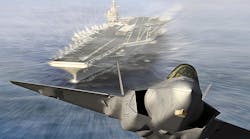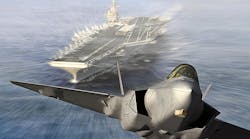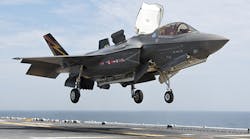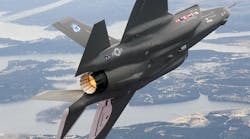Lockheed Martin Corp. continues to work to cut the cost of the F-35 Lightning II Joint Strike Fighters, even as it negotiates terms for the eleventh and largest production lot to date for that defense program. The goal is to cut a further $5 billion in overall costs from the F-35 program, which is slated to begin a series of production-rate increases in the coming decade.
The cost-cutting effort appears to be making progress. “President Trump and his administration have made clear they are focused on being smart buyers,” Lockheed CEO Marillyn Hewson told reporters and analysts this week.
Lockheed is the lead contractor for the F-35, a series of a stealth-enabled, single-engine aircraft developed as a common platform for combat and air defense. The jets will be used by the U.S Air Force, U.S. Marine Corp., U.S. Navy, and the U.K. Royal Air Force, as well as defense ministries in several NATO and other Allied nations. After a protracted development, production of the fighters has been underway for several years, but extraordinary costs have drawn criticism from opponents and backers.
Lockheed and other major contractors (BAE Systems, Northrup Grumman) committed to implement cost-cutting strategies and to meet new expense limits as early as 2014, and Lockheed has frequently restated its progress on these fronts. The program has over 1,300 suppliers however, making negotiations on prices difficult and time-consuming.
The program has already built about 200 aircraft, and in February Lockheed and the Dept. of Defense agreed to terms on the tenth Low Rate Initial Production contract for the F-35 — $8.2 billion for 90 aircraft, 55 for the U.S. defense forces and 35 for other nations (Australia, Italy, Norway, Turkey, and U.K.) Overall, the latest contract reportedly cut $728 million overall from the previous (Lot 9) award.
Still, the unit costs are significantly above the $85-million level that Lockheed has set as a goal. In Lot 10, each F-35A jet is project to cost $94.6 million (-7.3% compared to Lot 9); the F-35Bs are pegged at $122.8 million apiece (-6.7% from Lot 9); and each F-35C is projected at $121.8 million (7.9% reduction from Lot 9.)
Dept. of Defense budgeting calls for 63 F-35 purchases this year, 70 in in 2018, and 80 in 2019. From then, purchase volumes would accelerate, as Defense seeks a total of 2,443 F-35s by 2030.
The President’s role in the cost cutting is matter of some debate. After the November election, President-elect Trump criticized the jets’ costs and suggested that Defense may consider the Boeing F/A-18 Super Hornet as an alternative. When the $728 million in savings on the latest contract was announced, Trump’s involvement returned as a topic of debate.
Lockheed CEO Hewson appeared to appreciate his involvement, saying Trump “put a sharper focus on price.”










